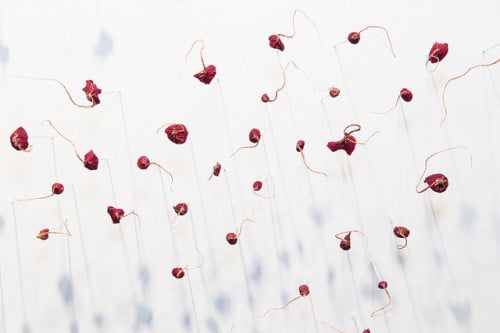
If an art exhibition could undergo psychoanalysis, we would probably ask Delanie Jenkins’s “Mixed Tape Transpositions,” at Stan McCollum Gallery through July 19, to lie on the couch just a little longer. Quiet yet powerful, subtle yet complex, the works in this exhibition teeter just close enough on the edge of obsession to make practicing artists familiar and to make casual observers unaware. For what Jenkins achieves in frames just over 19 by 23 inches is nothing short of remarkable but disquietingly uncomfortable at precisely the same time.
What is so intriguing about the works is Jenkins’s ongoing fascination with quotidian materials. She is a collector of tape, which she peels, places, removes and collects, almost hoarding fragments for future use until they appear in works like Full Circle (for Ruth Levine), a collage of tape fragments laid on a diagonal and cut into a circle, screen-printed black, so that somehow in the process the materiality of the piece is almost entirely obliterated. It becomes something that inhabits a space between painting, drawing, collage, assemblage, and found object work, yet it also shares a lineage with Op art and abstraction. Coming as it does as at the far end of a wall, you can almost read it as a period, or to use the more poetic term, a full stop.

In the main gallery, Jenkins juxtaposes an earthy exercise in mapping, the unusual Radix V, a mixed-media installation comprising dried radishes set on metal wires that undulate, its surface creating a topographic map that traces a journey from Pittsburgh to Atlanta. Only two points on the map are true, the starting and ending points, with everything in between being Jenkins’s artistic construction. This is in no way a criticism, as Radix V could suggest a host of things, and not being something particular gives viewers the space to overlay their own associations onto the work. It becomes anything – from an interstate to a mountain range to any other form of social or cultural mapping. But it also maps Jenkins’s process, and in its undulations and movements across the wall you can see how she finds the rhythms of the space. When viewed straight on it does fall neatly into our understandings of a map. When viewed from the side, with your face almost pressed into the wall, it becomes something else entirely.
Across the gallery, Jenkins sets up pairs that viewers will likely read as combinations and oppositions. Here, works with titles that include Blue & Red Pearl III next to Purple III and Blue & Yellow III next to Green III take spectators on what seems like a simple walk through color theory. While these facts are true—yellow and blue do make green, and blue and red do make purple—none of these optical impressions are truly at issue in the works. Instead, the focus is the physical properties of the tape and the interplays of its surfaces with the watercolor pencils she uses to inscribe upon it. On close inspection, Jenkins has layered what seems to be hundreds and hundreds, maybe thousands, of miniscule rectangles, each with small lines of the aforementioned colors, onto the page. So here are hundreds of pieces of white archival tape, each with a blue and yellow line; then another, and another, and again. Finally, when Jenkins has finished, the pieces of tape are trimmed into—in this case—a square.

This process is documented over and over, with this intimate experience drawing the viewer deeper and deeper. The whiteness of the wall and the whiteness of the mount and the whiteness of the tape and the almost opaque nature of the almost imperceptible hand-drawn lines of the respective colors on the almost obsessively cut rectangles of tape literally glue viewers to the works’ surfaces. It really does become something like an optical illusion or a color-blindness test, looking for variations in the tape. And they are there. Because Jenkins does every element of every piece by hand, they practically leap off the page with tension.
It helps to look at Trimmings, which is a collection of the trimmings that Jenkins salvaged from the archival tape works. Given her propensity to salvage everything for future reuse, the appearance of trimmings should come as no surprise. But in many ways Trimmings is a strong counterpart to Radix V simply because it too has a similar topography and a similar repetition, just on a much smaller scale.
Perhaps the easiest way to think about Jenkins’s exhibition is this: It is like being drawn into a vortex. The more two-dimensional tape works are so dense with information that they pull you in so closely that you almost feel like you are stuck to the surface. Just when you feel that you can’t look for a moment longer, just when your eyes are about to experience an optical effect, Jenkins drops in the third dimension, which pushes you away just a little and gives you just enough space to breathe.
Jenkins puts processes on display. It is in the torn edges of the tape or the trimmings, or in the blurred lines on the page that the marks of her hand and the deftness of her touch really come into play.
Brett Levine is a writer and curator based in Birmingham.






